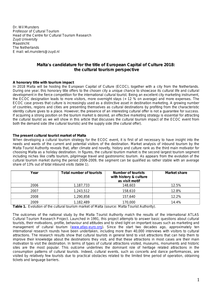DOCUMENT

The aim of this QSR 2022 on tourism is to make an attempt to assess available information about the tourism industry from three countries and various sources and present it in a comprehensive manner. We, thereby, describe common features of regional tourism structures, as well as differences, and we present some of the identified data incompatibilities (sections 2.2 and 2.3). The recommendations in section 3 present avenues along which data collection and monitoring can be improved, inspired by a set of key forces driving change intourism that stakeholders should be prepared for (section 2.4).
MULTIFILE
![Tourism [Wadden Sea Quality Status Report]](https://publinova-harvester-content-prod.s3.amazonaws.com/thumbnails/files/previews/pdf/20250506134122033770.20-20Wadden20Sea20Quality20Status20Report20-20Tourism-thumbnail-400x300.png)
This paper examines how a serious game approach could support a participatory planning process by bringing stakeholders together to discuss interventions that assist the development of sustainable urban tourism. A serious policy game was designed and played in six European cities by a total of 73 participants, reflecting a diverse array of tourism stakeholders. By observing in-game experiences, a pre- and post -game survey and short interviews six months after playing the game, the process and impact of the game was investigated. While it proved difficult to evaluate the value of a serious game approach, results demonstrate that enacting real-life policymaking in a serious game setting can enable stakeholders to come together, and become more aware of the issues and complexities involved with urban tourism planning. This suggests a serious game can be used to stimulate the uptake of academic insights in a playful manner. However, it should be remembered that a game is a tool and does not, in itself, lead to inclusive participatory policymaking and more sustainable urban tourism planning. Consequently, care needs to be taken to ensure inclusiveness and prevent marginalization or disempowerment both within game-design and the political formation of a wider participatory planning approach.
MULTIFILE

What would Dutch society lose if the Tourism and Recreation sector does not survive and what is needed to preserve its societal value and, preferably even, enhance this value? In this report a combination of methods is used to answer the research question: a literature study, case studies, and a survey among entrepreneurs. A substantial number of scientific articles, advisory reports and conference contributions were analysed in various contexts and for different forms of T&R. In the literature study societal contributions were brought together in a structured manner. The cases reflect the breadth of the sector and serve as good examples of how the sector achieves its societal value, but they also illustrate the challenges. The survey produced several insights. Respondents were asked, for instance, to indicate for each societal value whether they saw a positive, negative or no contribution of the sector. By means of a points system a top 25 was composed and put into a table., this table was used to structure the findings from the study.
DOCUMENT

In this paper we position sustainable tourism of the Wadden. The aim is to clarify the complex issues at stake and therewith provide a framework for future actions and policies.
DOCUMENT

De kandidatuur van Malta als Europese Culturele hoofdstad in cultuurtoeristisch perspectief
DOCUMENT

City authorities worldwide have sought to rejuvenate and diversify their tourism product offerings by dispersing visitors into less familiar and frequented locales. Despite calls to understand such ‘new tourism areas’ (NTAs) in urban areas, few researchers have examined visitor responses to the implementation of NTA strategies, particularly outside Europe. This quantitative approach considers the profiles, attitudes and behaviours of NTA visitors in an Asian city that was undertaking dispersal efforts pre-pandemic in the context of mass inbound Chinese visitation. Distinct profiles are found for NTA visitors relative to other city arrivals in response to Hong Kong’s branding propositions. It is found that NTAs appeal to repeat visitors seeking cosmopolitan experiences and may help tourist dispersal and product differentiation, though the proposition that NTA visitors are more highly educated was not supported
LINK
DOCUMENT

DOCUMENT
